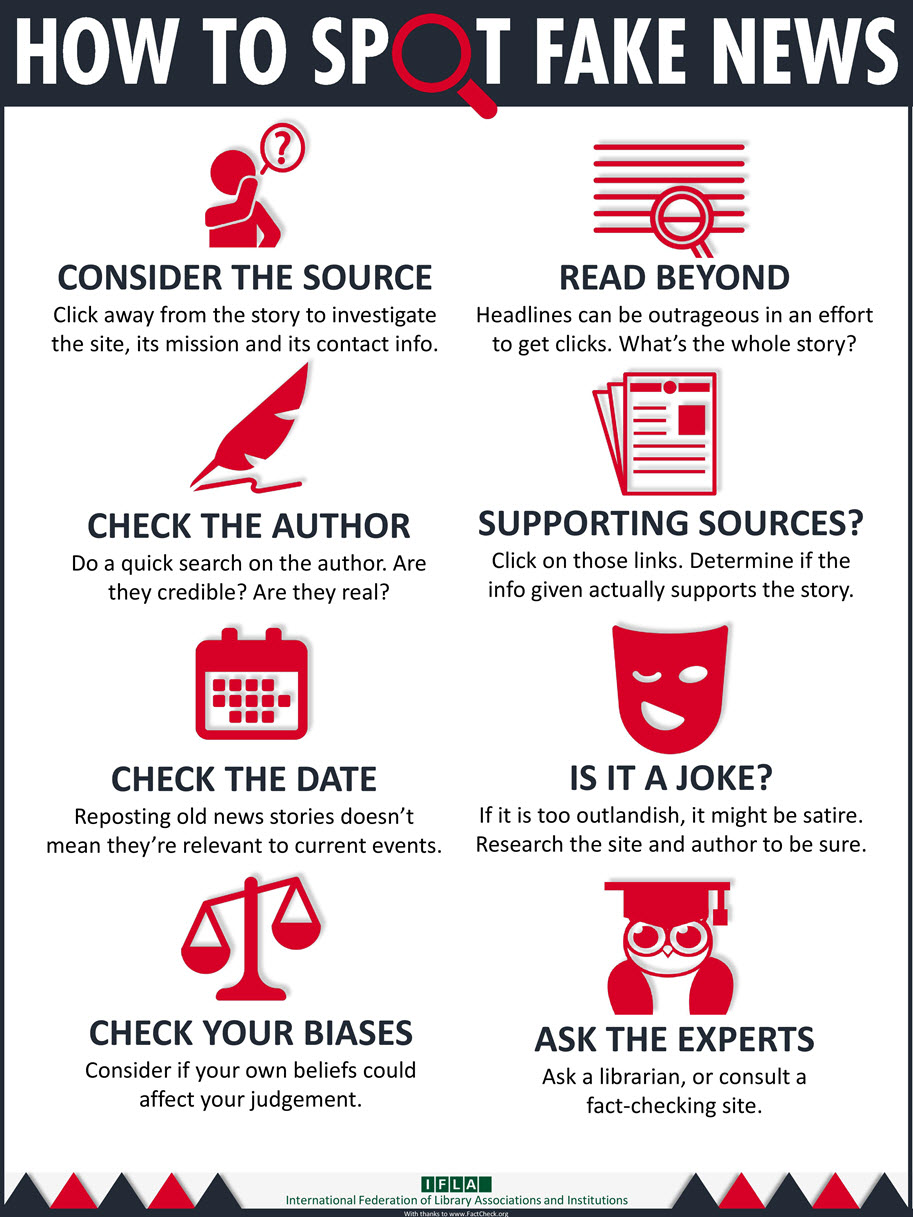ABOUT US
EXTRACURRICULAR ACTIVITIES
PARENTS
CHARGERS GUIDANCE

Digital Literacy: Spotting Fake News Online
Welcome to the BMRHS LMC digital literacy guide! In today's world, we get our news from all over the internet. But not everything we read is true. Let's learn how to tell the difference between real and fake news.
What Is Fake News?
Fake news is information that looks like news but isn't true. It can be made up to mislead people or as a joke. Either way, it's important to know how to spot it!
Why Does It Matter?
Stay Informed: Knowing the truth helps you understand what's happening in the world.
Make Good Decisions: Real news helps you make smart choices.
Avoid Spreading Lies: Sharing fake news can mislead others.
How to Spot Fake News
Here are some tips to help you identify fake news:
Check the Source:
Is it from a website you recognize and trust?
Look for reputable sources with good reputations.
Look at the Author:
Does the article have an author? If so, who are they?
Google them to see if they are real and credible.
Read Beyond the Headline:
Headlines can be misleading. Read the whole article to understand the full story.
Check the Date:
Make sure the news is current. Old news stories can resurface and cause confusion.
Verify with Other Sources:
Look for the same news on multiple reliable sites.
If only one site is reporting it, be cautious.
Is It a Joke?
Sometimes fake news is meant to be funny. Check if it’s from a satire site like The Onion.
Check Your Biases:
We all have opinions. Make sure you're not believing something just because it supports what you think.
Ask the Experts:
If you're not sure, ask a teacher or librarian!
Fun Tools and Resources
Check out these awesome resources to help you stay sharp:
FactCheck.org: Checks the facts on popular stories.
Snopes: Investigates rumors and myths.
Common Sense Media: Offers tips for staying safe and informed online.
MediaWise: Helps students identify misinformation.
News Literacy Project: Provides resources for understanding news literacy.
Stay Informed, Stay Smart
Remember, being a savvy news reader makes you smarter and more prepared for anything. Keep asking questions and checking facts, and you'll be on your way to becoming a digital detective!
Digital Literacy: AI and Digital Photo Manipulation
In the age of social media and digital content, photos are everywhere. But not all photos are what they seem. Let's explore how AI and digital tools can change photos and what that means for us.

Awwww. What a cute photo! Would you like this online or share it?
What Is Digital Photo Manipulation?
Digital photo manipulation is the process of changing or enhancing images using software. This can include anything from simple edits, like cropping or adjusting brightness, to more complex changes, like swapping backgrounds or altering someone's appearance.
How Does AI Fit In?
Artificial Intelligence (AI) can take photo editing to the next level. Here’s how:
Deepfakes: AI can create realistic-looking fake videos and photos by swapping faces or altering features. These can be hard to spot!
Image Enhancement: AI can improve photo quality, remove blemishes, or even add realistic-looking elements to photos.
Automated Edits: AI tools can automatically edit photos with filters, retouching, and more, making it easy for anyone to manipulate images.
Why Does It Matter?
Understanding photo manipulation is important because:
Real vs. Fake: Manipulated photos can mislead people. Knowing what’s real helps us make informed decisions.
Privacy Concerns: Edited images can be used to create fake profiles or spread misinformation.
Body Image Issues: Perfect-looking photos can create unrealistic beauty standards.
How to Spot Manipulated Photos
Here are some tips to identify altered images:
Look for Clues:
Check for unnatural shadows or reflections.
Look for blurry areas or mismatched lighting.
Check the Source:
Is the image from a credible website or person?
Reverse image search to see where it first appeared.
Examine the Details:
Zoom in on the photo to look for pixelation or inconsistencies.
Check if anything looks out of place or too perfect.
Use Tools:
Try websites like FotoForensics to analyze images.
Use Google’s reverse image search to find the original source.
Stay Skeptical:
If it seems too good (or strange) to be true, it might be manipulated.
Ask questions and seek out the truth.
Fun Tools and Resources
Explore these resources to learn more about photo manipulation:
Fotoforensics: Analyzes images for edits and inconsistencies.
Deepfake Detection Challenge: Learn about detecting deepfakes.
Sensity AI: Provides tools and information on AI-based image manipulation.
InVID Verification Plugin: A tool to verify videos and images.
Be a Savvy Image Viewer
Being aware of AI and photo manipulation helps you navigate the digital world with confidence. Keep questioning what you see and use your critical thinking skills to uncover the truth!

This is a real, unaltered photo. Juvenile bald eagles are a mixture of brown and white and reach full maturity in four to five years.